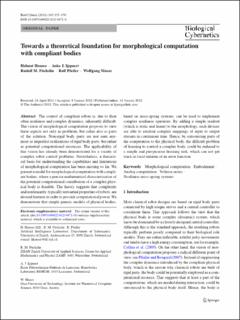Bitte benutzen Sie diese Kennung, um auf die Ressource zu verweisen:
https://doi.org/10.21256/zhaw-1668| Publikationstyp: | Beitrag in wissenschaftlicher Zeitschrift |
| Art der Begutachtung: | Peer review (Publikation) |
| Titel: | Towards a theoretical foundation for morphological computation with compliant bodies |
| Autor/-in: | Hauser, Helmut Ijspeert, Auke J. Füchslin, Rudolf Marcel Pfeifer, Rolf Maass, Wolfgang |
| DOI: | 10.21256/zhaw-1668 10.1007/s00422-012-0471-0 |
| Erschienen in: | Biological Cybernetics |
| Band(Heft): | 105 |
| Heft: | 5-6 |
| Seite(n): | 355 |
| Seiten bis: | 370 |
| Erscheinungsdatum: | Dez-2011 |
| Verlag / Hrsg. Institution: | Springer |
| ISSN: | 0340-1200 1432-0770 |
| Sprache: | Englisch |
| Schlagwörter: | Morphological computation; Embodiment; Analog computation; Volterra series; Nonlinear mass-spring systems |
| Fachgebiet (DDC): | 005: Computerprogrammierung, Programme und Daten |
| Zusammenfassung: | The control of compliant robots is, due to their often nonlinear and complex dynamics, inherently difficult. The vision of morphological computation proposes to view these aspects not only as problems, but rather also as parts of the solution. Non-rigid body parts are not seen anymore as imperfect realizations of rigid body parts, but rather as potential computational resources. The applicability of this vision has already been demonstrated for a variety of complex robot control problems. Nevertheless, a theoretical basis for understanding the capabilities and limitations of morphological computation has been missing so far. We present a model for morphological computation with compliant bodies, where a precise mathematical characterization of the potential computational contribution of a complex physical body is feasible. The theory suggests that complexity and nonlinearity, typically unwanted properties of robots, are desired features in order to provide computational power. We demonstrate that simple generic models of physical bodies, based on mass-spring systems, can be used to implement complex nonlinear operators. By adding a simple readout (which is static and linear) to the morphology such devices are able to emulate complex mappings of input to output streams in continuous time. Hence, by outsourcing parts of the computation to the physical body, the difficult problem of learning to control a complex body, could be reduced to a simple and perspicuous learning task, which can not get stuck in local minima of an error function. |
| Weitere Angaben: | Erworben im Rahmen der Schweizer Nationallizenzen (http://www.nationallizenzen.ch) |
| URI: | https://digitalcollection.zhaw.ch/handle/11475/2790 |
| Volltext Version: | Publizierte Version |
| Lizenz (gemäss Verlagsvertrag): | Lizenz gemäss Verlagsvertrag |
| Gesperrt bis: | 2017-01-01 |
| Departement: | School of Engineering |
| Enthalten in den Sammlungen: | Publikationen School of Engineering |
Dateien zu dieser Ressource:
| Datei | Beschreibung | Größe | Format | |
|---|---|---|---|---|
| 2011_Hauser_Towards a theoretical foundation_Biological Cybernetics.pdf | 1.61 MB | Adobe PDF |  Öffnen/Anzeigen |
Zur Langanzeige
Hauser, H., Ijspeert, A. J., Füchslin, R. M., Pfeifer, R., & Maass, W. (2011). Towards a theoretical foundation for morphological computation with compliant bodies. Biological Cybernetics, 105(5-6), 355–370. https://doi.org/10.21256/zhaw-1668
Hauser, H. et al. (2011) ‘Towards a theoretical foundation for morphological computation with compliant bodies’, Biological Cybernetics, 105(5-6), pp. 355–370. Available at: https://doi.org/10.21256/zhaw-1668.
H. Hauser, A. J. Ijspeert, R. M. Füchslin, R. Pfeifer, and W. Maass, “Towards a theoretical foundation for morphological computation with compliant bodies,” Biological Cybernetics, vol. 105, no. 5-6, pp. 355–370, Dec. 2011, doi: 10.21256/zhaw-1668.
HAUSER, Helmut, Auke J. IJSPEERT, Rudolf Marcel FÜCHSLIN, Rolf PFEIFER und Wolfgang MAASS, 2011. Towards a theoretical foundation for morphological computation with compliant bodies. Biological Cybernetics. Dezember 2011. Bd. 105, Nr. 5-6, S. 355–370. DOI 10.21256/zhaw-1668
Hauser, Helmut, Auke J. Ijspeert, Rudolf Marcel Füchslin, Rolf Pfeifer, and Wolfgang Maass. 2011. “Towards a Theoretical Foundation for Morphological Computation with Compliant Bodies.” Biological Cybernetics 105 (5-6): 355–70. https://doi.org/10.21256/zhaw-1668.
Hauser, Helmut, et al. “Towards a Theoretical Foundation for Morphological Computation with Compliant Bodies.” Biological Cybernetics, vol. 105, no. 5-6, Dec. 2011, pp. 355–70, https://doi.org/10.21256/zhaw-1668.
Alle Ressourcen in diesem Repository sind urheberrechtlich geschützt, soweit nicht anderweitig angezeigt.